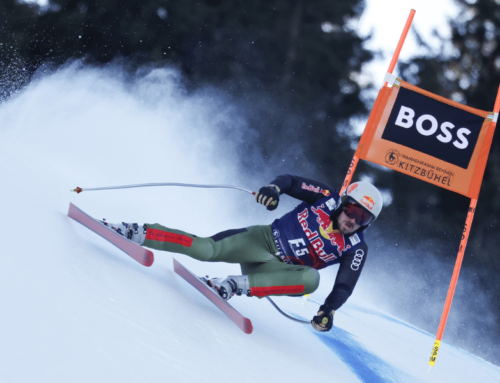The COVID effect on ‘Planet East’
COVID-19 turned the world upside down over the past year, but its effect was felt very differently across the country. On the surface, alpine ski racing looked similar east to west: Everyone wore masks; athletes answered COVID questions or questionnaires daily; spectators were shooed from finish areas. Beyond that, however, you might as well have been on different planets.
Planet East — with its extreme travel restrictions and quarantine protocols, on top of myriad regulations that varied state to state — often felt like it was the dark side of the moon.
Finding the sweet spot
The eastern region represents more than half of the entire U.S. Ski & Snowboard population, and includes eight different divisions and 13 states. On a typical year, Eastern Region Development Director Sam Damon oversees a region that, though geographically small, features a huge density and diversity of skiers. This year, finding a way for them all to compete became an extraordinarily complicated task. Despite early optimism that restrictions might ease enough to allow regional competitions (ranging from U-14 champs to FIS Eastern Cups) it soon became clear that the season would be all about divisional racing, which is to say, largely within state borders. Competing out of division carried quarantine, quota and cost issues that were a mighty deterrent.
“The main challenge was travel restrictions state to state,” says Damon, whose own travel stayed local due to restrictions and extra administrative tasks. “You had to figure out what each division could do, and they were all different.”
Making ski races happen involved working with all entities — FIS, USSS, resorts, clubs, state and local governments. Damon had to “find the sweet spot” in what he likens to a Venn diagram, where comfort levels of all entities intersected. On top of that, the vagaries of New England weather wreaked its own havoc throughout the east every step of the way, challenging even the most reliable venues to create a consistent surface for racing.

Here is a brief look at how the season rolled out in the northernmost part of the East, normally a hotbed of high-level racing.
- In December, many eastern programs, rather than travel to Colorado, went to Maine, the only state with good early season conditions. After the requisite quarantine and three weeks of training, the state of Maine banned all out of state athletes from competing in the scheduled competitions.
- Mother Nature brought an epic dump of snow to the heart of New England ski country the week before Christmas, and took it all away with torrential rains Christmas Eve. Unfavorable temperatures and lack of snow created a challenge throughout the season.
- In Vermont, there was no formal training possible until mid-December, and all youth sports competitions were paused until mid-January.
- In Vermont, when competitions started mid-January, athletes over age 19 were banned from all competitions because of a statewide rule meant to eliminate adult recreation leagues. By the time that rule was dropped for FIS ski racing, many college athletes had already left the state.
- NCAA racers were allowed to travel across states for competitions, but the waiver only applied to EISA carnivals, and only to athletes whose schools were fielding carnival teams.
- New Hampshire had no quarantine requirement for travel within New England, but a 10-day quarantine for anyone traveling in from beyond New England. Athletes who trained in Colorado, or raced in Europe, and returned to New England lost 8-10 days of training and competition on the back side.
- Vermont’s mandatory one-week quarantine and negative test when crossing into the state, meant losing 8-9 days (depending on test result turnaround) of training and/or competing for Vermont athletes, or a week of pre-race quarantine in Vermont for out of state athletes. Consequently, top racers in New Hampshire and Vermont stayed within their own borders.
- It was nearly March when Vermont allowed cross-state travel for athletes, and then only if they tested three times/week. Competing in Vermont for anyone required weekly PCR testing, at $55/ test. Crossing state borders added $165/week to the total ski racing price tag.
- With the top racers in the region split between New Hampshire and Vermont and many of the college skiers moving west, it took until March 17 for the east to have the first sub-30 penalty. Meanwhile, Rocky had been enjoying sub-30 penalties since November, the western region since December.
- A shortage of TD’s (an all-volunteer network, affected by travel restrictions and weekday scheduling) caused some FIS races to be canceled.
- New York loosened travel rules partway through the winter, allowing racing between contiguous states without quarantine, but if the contiguous state’s quarantine restrictions were onerous (see Vermont above) travel was not viable.
Fallout at the FIS level

For older and high-level FIS athletes, the East was a tough place to move ahead. The lowest penalty races nationally were only available out of region, and the lowest regionally were across divisions. Accessing either ranged from tough to impossible. Competing out of region meant snagging one of only five quota spots allotted to each region. Competing out of division, whether in Europe, across the country or across the state line, carried the penalty of vastly fewer training and competition days. Each out-of-division trip meant losing 7-10 days of training or racing. Such a tradeoff added weight to the decision to pursue point opportunities out of division or region. Athletes elsewhere in the country could travel out of the region or the country and continue racing or training with no disruption.
“We’re very grateful to the state of Vermont for enabling training to happen,” says Burke Mountain Academy Headmaster Willy Booker. Many factors, however, made ski racing in Vermont more complicated than nearly everywhere else in the country — or the world. Among the toughest issues were days on snow lost to quarantine. For Burke students, the return from a Colorado training trip and from Christmas vacation worked out to a minimum of 14-20 in-season days on snow that every kid missed. “That was after also having missed off-season and pre-season training blocks,” says Booker.
High anxiety, tight quarters
Booker describes the high-pressure situation in December and January when kids watched their peers elsewhere racing and scoring on live timing. And yet, when these same kids were offered a trip out of region, knowing they would lose the quarantine days on the other side, few were willing to take the option.
“Globally and domestically, access to racing and training was really inequitable over last 14 months,” says Booker, who is eager to see eastern athletes get due consideration for their circumstances. “Without the benefit of head-to-head competition, on top of that inequality, it is difficult to make selections.”
Even with limited field sizes, and mostly weekday races (to accommodate youth programming on weekends at already crowded areas), Damon described New Hampshire racing as “tight quarters.” This was true at the FIS level, with coveted out-of-division quota spots, and at children’s races as well. New Hampshire normally races state-wide at the U16 level, but broke into smaller councils. Still, midseason the 100-person fields filled up online in 3-5 minutes.
The upside?
While the racing fields in Vermont and New Hampshire were tight and deep, making it difficult to break in with a high bib number, entry level FIS athletes outside of New Hampshire and Vermont enjoyed the bonus of much smaller fields than normal. Terry Delliquadri is the director of alpine skiing at Northwood School in Lake Placid, N.Y. Once the season started, his athletes, faced with quarantine on both ends of travel, did not leave the state. Consequently, Whiteface hosted 66 races this year.
For women, the field sizes were often too small for the races to offer much benefit. For first-year FIS men, however, who normally have a hard time even getting into races, Delliquadri called it “a really good FIS season” with regard to access. “Somebody with 500 points, could start 35th instead of 140th,” he noted. Other beneficiaries were Northwood’s U16 racers, who got a lifetime of forerunning FIS races this season.
Some takeaways
The East is unique: “The scale in the East is so different,” says Damon. “You can’t make every decision based on how it is in one place. Burke and Franconia are 45 minutes away, but they might as well have been across the country.”
Divisional racing broadened access: Divisional racing, especially early season opened up opportunities for more people and made it accessible (a day trip versus a road trip).
National and regional access broadened perspective: Points alone are an imperfect marker, and need to be cross-checked with head-to-head competition.
Grateful for great people: Damon gives huge credit to Eastern Alpine Program Manager Paige Roberts for working with and connecting so many people and entities. Race organizers also stepped up and took on much greater roles because USSS staff was unable to support on-site.
It happened! “To me we proved that we can do this really well in a low-risk way,” says Damon, who is not aware of a single COVID transmission at a USSS eastern event this year.
Have some thoughts on this? Send a letter to the editor. If it’s good, we’ll publish it.





















